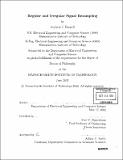| dc.contributor.advisor | Alan V. Oppenheim. | en_US |
| dc.contributor.author | Russell, Andrew Ian, 1975- | en_US |
| dc.contributor.other | Massachusetts Institute of Technology. Dept. of Electrical Engineering and Computer Science. | en_US |
| dc.date.accessioned | 2006-03-24T16:23:08Z | |
| dc.date.available | 2006-03-24T16:23:08Z | |
| dc.date.copyright | 2002 | en_US |
| dc.date.issued | 2002 | en_US |
| dc.identifier.uri | http://hdl.handle.net/1721.1/29761 | |
| dc.description | Thesis (Ph. D.)--Massachusetts Institute of Technology, Dept. of Electrical Engineering and Computer Science, 2002. | en_US |
| dc.description | Includes bibliographical references (p. 107-110). | en_US |
| dc.description.abstract | In this thesis, we consider three main resampling problems. The first is the sampling rate conversion problem in which the input and output grids are both regularly spaced. It is known that the output signal is obtained by applying a time-varying filter to the input signal. The existing methods for finding the coefficients of this filter inherently tradeoff computational and memory requirements. Instead, we present a recursive scheme for which the computational and memory requirements are both low. In the second problem which we consider, we are given the instantaneous samples of a continuous-time (CT) signal taken on an irregular grid from which we wish to obtain samples on a regular grid. This is referred to as the nonuniform sampling problem. We present a noniterative algorithm for solving this problem, which, in contrast to the known iterative algorithms, can easily be implemented in real time. We show that each output point may be calculated by using only a finite number of input points, with an error which falls exponentially in the number of points used. Finally we look at the nonuniform lowpass reconstruction problem. In this case, we are given regular samples of a CT signal from which we wish to obtain amplitudes for a sequence of irregularly spaced impulses. These amplitudes are chosen so that the original CT signal may be recovered by lowpass filtering this sequence of impulses. We present a general solution which exhibits the same exponential localization obtained for the nonuniform sampling problem. We also consider a special case in which the irregular grid is obtained by deleting a single point from an otherwise regular grid. We refer | en_US |
| dc.description.abstract | (cont.) to this as the missing pixel problem, since it may be used to model cases in which a single defective element is present in a regularly spaced array such as the pixel arrays used in flat-panel video displays. We present an optimal solution which minimizes the energy of the reconstruction error, subject to the constraint that only a given number of pixels may be adjusted. | en_US |
| dc.description.statementofresponsibility | by Andrew I. Russell. | en_US |
| dc.format.extent | 110 p. | en_US |
| dc.format.extent | 4753790 bytes | |
| dc.format.extent | 4753599 bytes | |
| dc.format.mimetype | application/pdf | |
| dc.format.mimetype | application/pdf | |
| dc.language.iso | eng | en_US |
| dc.publisher | Massachusetts Institute of Technology | en_US |
| dc.rights | M.I.T. theses are protected by copyright. They may be viewed from this source for any purpose, but reproduction or distribution in any format is prohibited without written permission. See provided URL for inquiries about permission. | en_US |
| dc.rights.uri | http://dspace.mit.edu/handle/1721.1/7582 | |
| dc.subject | Electrical Engineering and Computer Science. | en_US |
| dc.title | Regular and irregular signal resampling | en_US |
| dc.type | Thesis | en_US |
| dc.description.degree | Ph.D. | en_US |
| dc.contributor.department | Massachusetts Institute of Technology. Department of Electrical Engineering and Computer Science | |
| dc.identifier.oclc | 54666109 | en_US |
